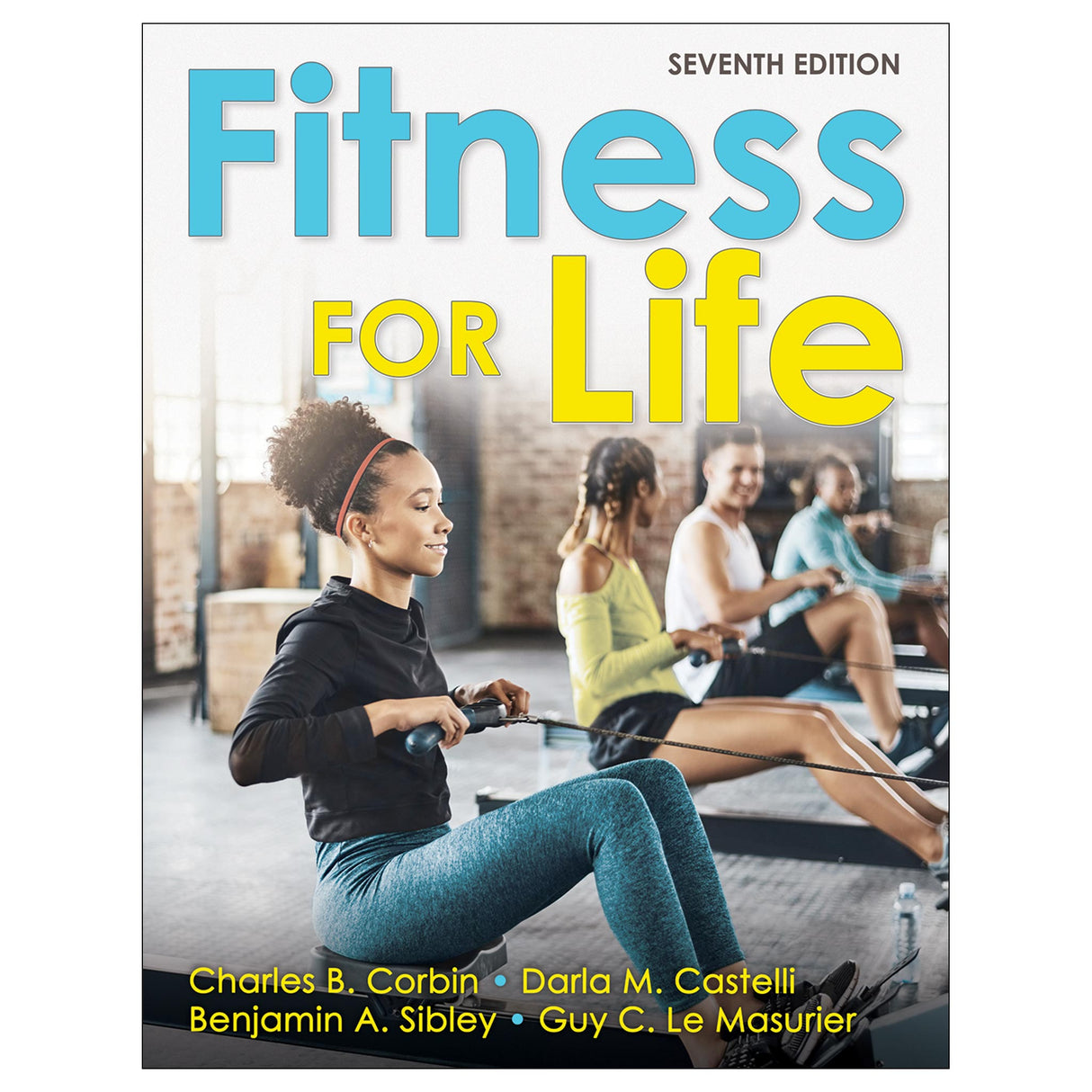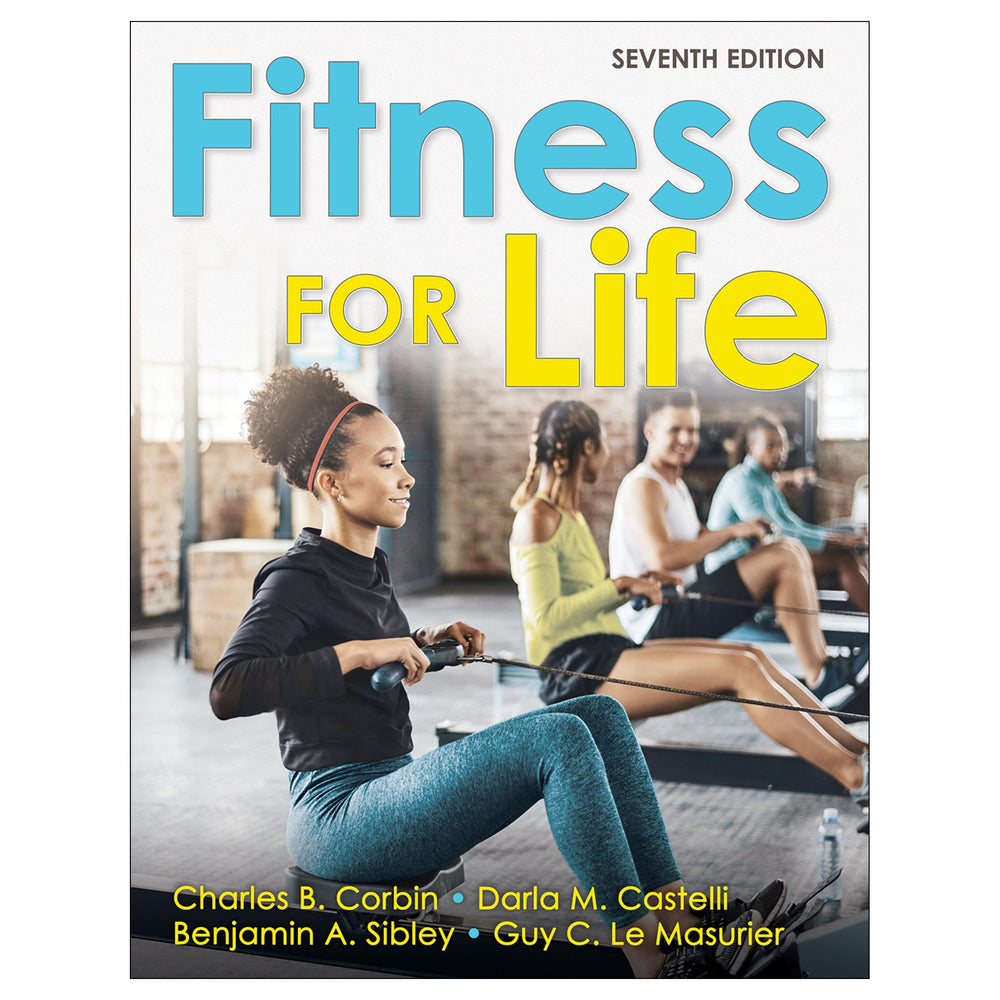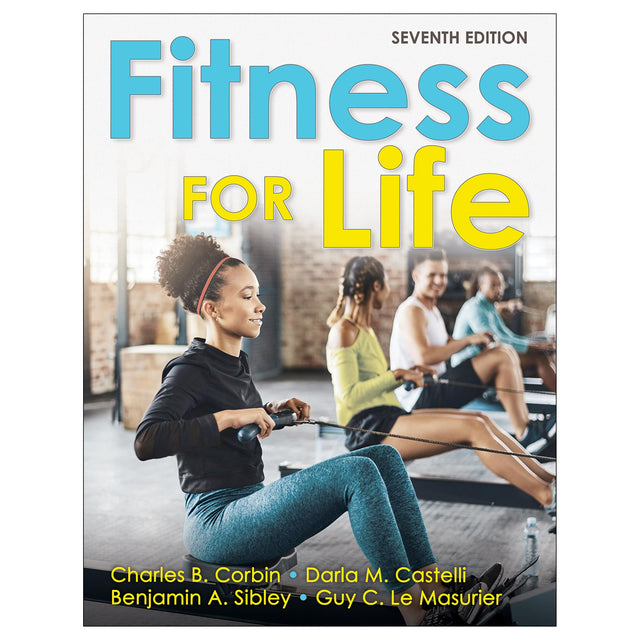Fitness for Life 7th Edition Paper With Web Resource
$74.00 USD
New to This Edition
Fitness for Life is more than a fitness education program—it’s a conceptual physical education (CPE) program that addresses all national physical education standards. New features include the following:
- Fully updated content includes new videos, photos, and ancillaries.
- Universal design principles provide accessibility for all students.
- Reorganized chapters enhance content flow.
- New emphasis is placed on physical literacy and health literacy.
- There is expanded coverage of social-emotional learning.
- A modular approach and a comprehensive teacher’s guide support different schedules and remote learning, in-class learning, and blended approaches.
- A new delivery platform, HKPropel, allows teachers to assign worksheets and projects, check on student progress, receive reports, and automatically scores tests.
- An online teacher training course, free to adopters of the student text, includes a test for those who want to earn a certificate of completion.
Fitness for Life comes with an array of resources, including a print text and ebook with web resource, an interactive web text, and teacher ancillaries.
The student text offers 21 chapters in seven units. Chapters include lesson objectives, vocabulary words, muscle art, and self-assessments. Other special features in the book include Tech Trends, Fit Facts, Science in Action, Academic Connection, Taking Action activities, and Consumer Corner.
To assist students using the print book or ebook, the Fitness for Life, Seventh Edition, Web Resource features easy access to material referenced in the text, including vocabulary terms with English and Spanish definitions and audio pronunciations, worksheets, and chapter reviews.
Fitness for Life, Seventh Edition, is also available as an interactive web text, which students can access from a computer, tablet, or mobile device. The student interactive web textbook contains the same content as the print book but uses interactive audio, video, worksheets, and other great activities to help students engage with the material and enhance learning. The interactive web textbook offers audio vocabulary and definitions in English and Spanish. Introductory videos at the beginning of each lesson help students assess their knowledge going in, while videos at the end of each lesson help students put what they’ve learned into context.
Enduring Features of This Iconic Text
- Meets SHAPE America’s latest grade-level standards and outcomes
- Employs Dr. Corbin’s iconic HELP philosophy and Stairway to Lifetime Fitness, Health, and Wellness approach
- Helps students become informed consumers about physical activity and fitness
- Helps develop students’ self-management skills
- Separates fitness facts from fiction
Note: A code for accessing HKPropel is included with all new print books.
Audience
Student text for secondary school personal fitness courses.Chapter 1. Fitness, Health, and Wellness for All
Lesson 1.1 Lifelong Fitness, Health, and Wellness
Self-Assessment: Physical Fitness Challenges
Lesson 1.2 Developing Health and Physical Literacy
Taking Charge: Communication
Self-Management: Skills for Effective Communication
Taking Action: The Warm-Up
Chapter Review
Chapter 2. Physical Activity and Healthy Lifestyles for All
Lesson 2.1 Adopting Healthy Lifestyles
Self-Assessment: Practicing Physical Fitness Tests
Lesson 2.2 Learning Self-Management Skills
Taking Charge: Self-Assessment
Self-Management: Skills for Self-Assessment
Taking Action: Fitness Trails
Chapter Review
Chapter 3. Goal Setting and Program Planning
Lesson 3.1 Goal Setting
Self-Assessment: Assessing Muscle Fitness
Lesson 3.2 Program Planning
Taking Charge: Setting Goals
Self-Management: Skills for Setting Goals
Taking Action: Exercise Circuits
Chapter Review
Unit II: Safe and Smart Health-Enhancing Physical Activity
Chapter 4. Safe and Smart Physical Activity
Lesson 4.1 Readiness for Physical Activity
Self-Assessment: Body Composition and Flexibility
Lesson 4.2 Safe and Injury-Free Physical Activity
Taking Charge: Overcoming Barriers
Self-Management: Skills for Overcoming Barriers
Taking Action: Safe Exercise Circuit
Chapter Review
Chapter 5. Social, Health, and Wellness Benefits of Physical Activity
Lesson 5.1 Benefits of Social Interactions in Physical Activity
Self-Assessment: Modifying Rules in Games
Lesson 5.2 Health and Wellness Benefits of Physical Activity
Taking Charge: Conflict Resolution
Self-Management: Skills for Conflict Resolution
Taking Action: Team Building
Chapter Review
Chapter 6. How Much Is Enough?
Lesson 6.1 How Much Physical Activity Is Enough?
Self-Assessment: PACER and Trunk Lift
Lesson 6.2 How Much Fitness Is Enough?
Taking Charge: Learning to Self-Monitor
Self-Management: Skills for Self-Monitoring
Taking Action: Physical Activity Pyramid Circuit
Chapter Review
Unit III: Moderate and Vigorous Physical Activity
Chapter 7. Moderate Physical Activity and Avoiding Sedentary Living
Lesson 7.1 Moderate Physical Activity Facts
Self-Assessment: Walking Test
Lesson 7.2 Preparing a Moderate Physical Activity Plan
Taking Charge: Learning to Manage Time
Self-Management: Skills for Managing Time
Taking Action: Performing Your Moderate Physical Activity Plan
Chapter Review
Chapter 8. Cardiorespiratory Endurance
Lesson 8.1 Cardiorespiratory Endurance Facts
Self-Assessment: Step Test and One-Mile Run Test
Lesson 8.2 Building Cardiorespiratory Endurance
Taking Charge: Self-Confidence
Self-Management: Skills for Building Self-Confidence
Taking Action: Target Heart Rate Workouts
Chapter Review
Chapter 9. Vigorous Physical Activity
Lesson 9.1 Vigorous Aerobics, Sports, and Recreation
Self-Assessment: Assessing Jogging Techniques
Lesson 9.2 Anaerobic Activities, Mixed Fitness Activities, and Vigorous Activity Planning
Taking Charge: Improving Performance Skills
Self-Management: Skills for Improving Performance
Taking Action: Performing Your Vigorous Physical Activity Plan
Chapter Review
Unit IV. Muscle Fitness and Flexibility
Chapter 10. Muscle Fitness Basics
Lesson 10.1 Muscle Fitness Facts
Self-Assessment: Muscle Fitness Testing
Lesson 10.2 Building Muscle Fitness
Taking Charge: Preventing Relapse
Self-Management: Skills for Preventing Relapse
Taking Action: Resistance Machine Exercises
Chapter Review
Chapter 11. Muscle Fitness Applications
Lesson 11.1 Core Fitness, Posture, and Back Care
Self-Assessment: Healthy Back Test
Lesson 11.2 Muscle Fitness Exercise Planning and Ergogenic Aids
Taking Charge: Finding Social Support
Self-Management: Skills for Finding Social Support
Taking Action: Performing Your Muscle Fitness Exercise Plan
Chapter Review
Chapter 12. Flexibility
Lesson 12.1 Flexibility Facts
Self-Assessment: Arm, Leg, and Trunk Flexibility
Lesson 12.2 Preparing a Flexibility Exercise Plan
Taking Charge: Building Knowledge and Understanding
Self-Management: Skills for Building Knowledge and Understanding
Taking Action: Performing Your Flexibility Exercise Plan
Chapter Review
Unit V: Skills and Skill-Related Fitness, Body Composition, and Program Planning
Chapter 13. Skill-Related Fitness, Skills, Tactics, and Strategy
Lesson 13.1 Skill-Related Physical Fitness and Skills
Self-Assessment: Assessing Skill-Related Physical Fitness
Lesson 13.2 Strategy and Tactics
Taking Charge: Developing Tactics
Self-Management: Skills for Developing Tactics
Taking Action: Skill Learning Experiment
Chapter Review
Chapter 14. Body Composition and Energy Balance
Lesson 14.1 Body Composition Facts
Self-Assessment: Body Measurements
Lesson 14.2 Energy Balance
Taking Charge: Improving Physical Self-Perception
Self-Management: Skills for Improving Physical Self-Perception
Taking Action: Elastic Band Workout
Chapter Review
Chapter 15. Planning and Maintaining Active Lifestyles
Lesson 15.1 Preparing a Comprehensive Physical Activity Plan
Self-Assessment: Your Personal Fitness Test Battery
Lesson 15.2 Maintaining Active Lifestyles
Taking Charge: Changing Attitudes
Self-Management: Skills for Building Positive Attitudes
Taking Action: Performing Your Physical Activity Plan
Chapter Review
Unit VI: Living Well: Making Healthy Choices
Chapter 16. Choosing Nutritious Food
Lesson 16.1 A Healthy Diet
Self-Assessment: Energy Balance
Lesson 16.2 Making Healthy Food Choices
Taking Charge: Saying No
Self-Management: Skills for Saying No
Taking Action: Burn It Up Workout
Chapter Review
Chapter 17. Stress Management
Lesson 17.1 Facts About Stress
Self-Assessment: Identifying Signs of Stress
Lesson 17.2 Managing Stress
Taking Charge: Managing Competitive Stress
Self-Management: Skills for Managing Competitive Stress
Taking Action: Performing Relaxation Exercises
Chapter Review
Chapter 18. Making Healthy Choices and Planning for Health and Wellness
Lesson 18.1 Lifestyle Choices for Fitness, Health, and Wellness
Self-Assessment: Healthy Lifestyle Questionnaire
Lesson 18.2 Healthy Lifestyle Planning
Taking Charge: Thinking Success
Self-Management: Skills for Thinking Success
Taking Action: Your Healthy Lifestyle Plan
Chapter Review
Unit VII: Moving Through Life
Chapter 19. Making Good Consumer Choices
Lesson 19.1 Health and Fitness Quackery
Self-Assessment: Assessing Your Posture
Lesson 19.2 Evaluating Health Clubs, Equipment, Media, and Internet Materials
Taking Charge: Learning to Think Critically
Self-Management: Skills for Thinking Critically
Taking Action: Your Health and Fitness Club
Chapter Review
Chapter 20. The Science of Active Living
Lesson 20.1 Moving Your Body
Self-Assessment: Analyzing Basic Skills
Lesson 20.2 Moving Implements and Objects
Taking Charge: Positive Self-Talk
Self-Management: Skills for Positive Self-Talk
Taking Action: Applying Principles
Chapter Review
Chapter 21. Taking Advantage of Opportunities
Lesson 21.1 Active Living Opportunities
Self-Assessment: Opportunities for Physical Activity Participation Questionnaire
Lesson 21.2 Physical Education and Career Opportunities
Taking Charge: Choosing Good Activities
Self-Management: Skills for Choosing Good Activities
Taking Action: Taking Advantage of Opportunities
Chapter Review
Stairway to Lifetime Fitness, Health, and Wellness
The New Physical Activity Pyramid
What Is Physical Literacy? What Is Health Literacy?
FFL 7E TEKS Alignment Interactive Web Text
FFL 7E TEKS Alignment Print Book
Fitness for Life adopters have access to a Teacher Collection that provides online resources for students and teachers through HKPropel, a platform that makes it easy to access and use online materials that enhance learning and instruction.
Teacher HKPropel resources include the following:
- An introduction that describes physical literacy, health literacy, and the foundation sciences behind Fitness for Life
- Daily lesson plans, with five lessons (two classroom plans and three activity plans) per chapter
- Worksheets that allow students to complete assignments for assessment portfolios
- Premade lesson and chapter quizzes with answers
- Unit tests with answers
- Activity cards
- A presentation package of slides with the key points for each classroom lesson
- A test bank that teachers can use to make their own quizzes and tests if they prefer
For schools that adopt the text with web resource available through HKPropel, students also have online access to vocabulary terms with English and Spanish definitions and audio pronunciations, worksheets, and chapter reviews. For schools that adopt the interactive web text available through HKPropel, students also gain online access to video clips demonstrating self-assessments and exercises, give-it-a-try activities, worksheets for completing assignments, review questions, and vocabulary flip cards. Teachers can track students’ progress through each chapter in the interactive web text.





